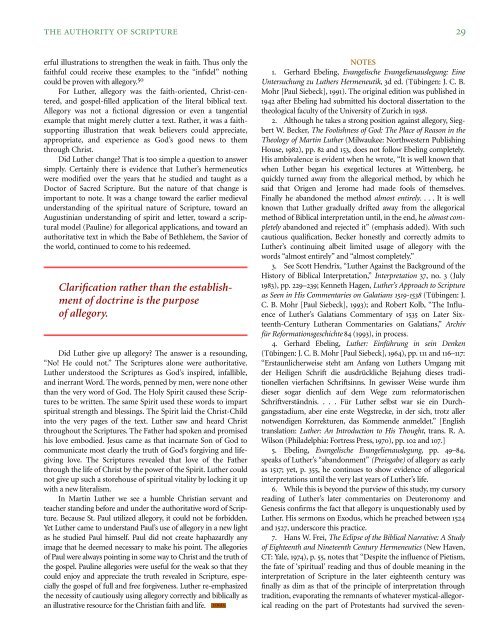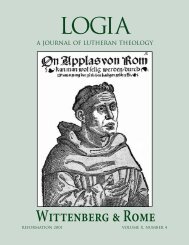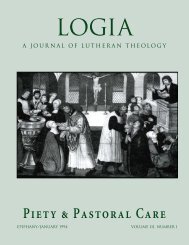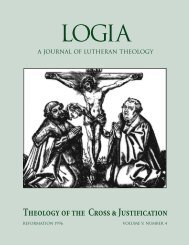04-2 Hermeneutics.pdf
04-2 Hermeneutics.pdf
04-2 Hermeneutics.pdf
- No tags were found...
Create successful ePaper yourself
Turn your PDF publications into a flip-book with our unique Google optimized e-Paper software.
THE AUTHORITY OF SCRIPTURE 29erful illustrations to strengthen the weak in faith. Thus only thefaithful could receive these examples; to the “infidel” nothingcould be proven with allegory. 50For Luther, allegory was the faith-oriented, Christ-centered,and gospel-filled application of the literal biblical text.Allegory was not a fictional digression or even a tangentialexample that might merely clutter a text. Rather, it was a faithsupportingillustration that weak believers could appreciate,appropriate, and experience as God’s good news to themthrough Christ.Did Luther change? That is too simple a question to answersimply. Certainly there is evidence that Luther’s hermeneuticswere modified over the years that he studied and taught as aDoctor of Sacred Scripture. But the nature of that change isimportant to note. It was a change toward the earlier medievalunderstanding of the spiritual nature of Scripture, toward anAugustinian understanding of spirit and letter, toward a scripturalmodel (Pauline) for allegorical applications, and toward anauthoritative text in which the Babe of Bethlehem, the Savior ofthe world, continued to come to his redeemed.Clarification rather than the establishmentof doctrine is the purposeof allegory.nbDid Luther give up allegory? The answer is a resounding,“No! He could not.” The Scriptures alone were authoritative.Luther understood the Scriptures as God’s inspired, infallible,and inerrant Word. The words, penned by men, were none otherthan the very word of God. The Holy Spirit caused these Scripturesto be written. The same Spirit used these words to impartspiritual strength and blessings. The Spirit laid the Christ-Childinto the very pages of the text. Luther saw and heard Christthroughout the Scriptures. The Father had spoken and promisedhis love embodied. Jesus came as that incarnate Son of God tocommunicate most clearly the truth of God’s forgiving and lifegivinglove. The Scriptures revealed that love of the Fatherthrough the life of Christ by the power of the Spirit. Luther couldnot give up such a storehouse of spiritual vitality by locking it upwith a new literalism.In Martin Luther we see a humble Christian servant andteacher standing before and under the authoritative word of Scripture.Because St. Paul utilized allegory, it could not be forbidden.Yet Luther came to understand Paul’s use of allegory in a new lightas he studied Paul himself. Paul did not create haphazardly anyimage that he deemed necessary to make his point. The allegoriesof Paul were always pointing in some way to Christ and the truth ofthe gospel. Pauline allegories were useful for the weak so that theycould enjoy and appreciate the truth revealed in Scripture, especiallythe gospel of full and free forgiveness. Luther re-emphasizedthe necessity of cautiously using allegory correctly and biblically asan illustrative resource for the Christian faith and life. LOGIANOTES1. Gerhard Ebeling, Evangelische Evangelienauslegung: EineUntersuchung zu Luthers Hermeneutik, 3d ed. (Tübingen: J. C. B.Mohr [Paul Siebeck], 1991). The original edition was published in1942 after Ebeling had submitted his doctoral dissertation to thetheological faculty of the University of Zurich in 1938.2. Although he takes a strong position against allegory, SiegbertW. Becker, The Foolishness of God: The Place of Reason in theTheology of Martin Luther (Milwaukee: Northwestern PublishingHouse, 1982), pp. 82 and 153, does not follow Ebeling completely.His ambivalence is evident when he wrote, “It is well known thatwhen Luther began his exegetical lectures at Wittenberg, hequickly turned away from the allegorical method, by which hesaid that Origen and Jerome had made fools of themselves.Finally he abandoned the method almost entirely. ...It is wellknown that Luther gradually drifted away from the allegoricalmethod of Biblical interpretation until, in the end, he almost completelyabandoned and rejected it” (emphasis added). With suchcautious qualification, Becker honestly and correctly admits toLuther’s continuing albeit limited usage of allegory with thewords “almost entirely” and “almost completely.”3. See Scott Hendrix, “Luther Against the Background of theHistory of Biblical Interpretation,” Interpretation 37, no. 3 (July1983), pp. 229–239; Kenneth Hagen, Luther’s Approach to Scriptureas Seen in His Commentaries on Galatians 1519-1538 (Tübingen: J.C. B. Mohr [Paul Siebeck], 1993); and Robert Kolb, “The Influenceof Luther’s Galatians Commentary of 1535 on Later Sixteenth-CenturyLutheran Commentaries on Galatians,” Archivfür Reformationsgeschichte 84 (1993), in process.4. Gerhard Ebeling, Luther: Einführung in sein Denken(Tübingen: J. C. B. Mohr [Paul Siebeck], 1964), pp. 111 and 116–117:“Erstaunlicherweise steht am Anfang von Luthers Umgang mitder Heiligen Schrift die ausdrückliche Bejahung dieses traditionellenvierfachen Schriftsinns. In gewisser Weise wurde ihmdieser sogar dienlich auf dem Wege zum reformatorischenSchriftverständnis. . . . Für Luther selbst war sie ein Durchgangsstadium,aber eine erste Wegstrecke, in der sich, trotz allernotwendigen Korrekturen, das Kommende anmeldet.” [Englishtranslation: Luther: An Introduction to His Thought, trans. R. A.Wilson (Philadelphia: Fortress Press, 1970), pp. 102 and 107.]5. Ebeling, Evangelische Evangelienauslegung, pp. 49–84,speaks of Luther’s “abandonment” (Preisgabe) of allegory as earlyas 1517; yet, p. 355, he continues to show evidence of allegoricalinterpretations until the very last years of Luther’s life.6. While this is beyond the purview of this study, my cursoryreading of Luther’s later commentaries on Deuteronomy andGenesis confirms the fact that allegory is unquestionably used byLuther. His sermons on Exodus, which he preached between 1524and 1527, underscore this practice.7. Hans W. Frei, The Eclipse of the Biblical Narrative: A Studyof Eighteenth and Nineteenth Century <strong>Hermeneutics</strong> (New Haven,CT: Yale, 1974), p. 55, notes that “Despite the influence of Pietism,the fate of ‘spiritual’ reading and thus of double meaning in theinterpretation of Scripture in the later eighteenth century wasfinally as dim as that of the principle of interpretation throughtradition, evaporating the remnants of whatever mystical-allegoricalreading on the part of Protestants had survived the seven-
















